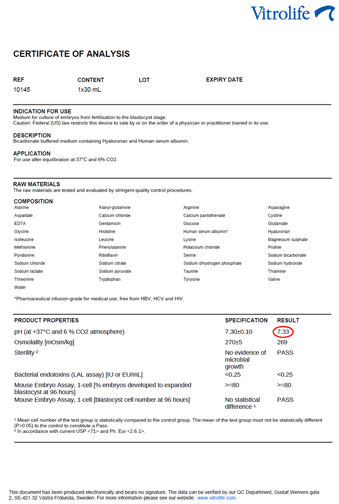The physiological pH for human gametes and embryos is generally thought to be between 7.2 and 7.4. In order to maintain this range of pH during culture, i.e. to create a similar environment to that of the human reproductive tract, we use CO2 gas inside various types of incubators (this blog post by Markus Montag – “Considerations for embryos culture at high altitude”, further explains this).
Atmospheric air consists of approximately 78% nitrogen (N2), 21% oxygen (O2) and <1% other gasses, of which only 0.06% is carbon dioxide (CO2). If we want to create a pH between 7.2 and 7.4 in Vitrolife bicarbonate buffered culture media, we need a CO2 concentration of 6% at sea level, which is a much higher concentration than what is present in atmospheric air. This is why we constantly need to inject CO2 into the incubator during in vitro culture. When incubator doors are opened, especially if there are no sectioned inner doors to reduce the amount of CO2 being lost during openings, it is difficult to maintain a stable CO2 concentration of 6%.

Each batch of Vitrolife media is released with a Certificate of Analysis (COA) and the release pH for each product can be found here to optimize the CO2 concentration of your incubator accordingly.
We refer to a CO2 value at sea level because the partial gas pressure is reduced at higher altitudes. The higher you go above sea level, the higher CO2 concentration you need to achieve the same pH value. Markus Montag explains this very nicely in the Vitrolife Blog “Considerations for embryo culture at high altitude”. Other culture media may require 5% CO2 at sea level to achieve the physiological pH of 7.2 – 7.4, due to differences in media compositions. These differences can make it difficult to compare 2 media systems in the same incubator.
There have been numerous studies showing the benefit of a reduced O2 concentration (5.0%) during in vitro culture of mammalian embryos (see prof. David Gardner’s blog post “Oxygen: Dr Jekyll or Mr Hyde?” for more information). Atmospheric oxygen level appears to be detrimental to human embryo development and viability. In vivo, fertilization and embryo development occur at low oxygen tension of around 2–8%. By reducing the exposure of embryos to a high concentration of O2 (21.0%), you are able to reduce the oxidative stress embryos are exposed to during in vitro culture. One way of reducing the O2 concentration during in vitro culture is to increase the nitrogen gas (N2) concentration by directly injecting it into the incubator and thus displacing the O2 from the incubator. However, nowadays one can also install a N2 gas generator which generates N2 gas from liquid nitrogen, i.e. you ”harvest” the vapor from liquid N2 tanks to produce N2. Alternatively, you can also purchase special “pre-mixed” gas tanks. These tanks have already been filled with a known mixture of 5-6% CO2 and 5.0% O2 with the remaining volume consisting mainly of N2. Even though the content of these mixed-gas tanks are “known”, it is good practice to verify their contents with a gas analyser.
|
In summary:
|
Further reading:
Considerations for embryo culture at high altitude by Dr. Markus Montag
Oxygen: Dr Jekyll or Mr Hyde? by Prof. David K Gardner
Topics: Did you know?
